Even in ancient times, it was believed that flint was a symbol associated with fire and water.
There is an opinion that the Stone Age began with it: products made from this stone were used by the very first people. It is also capable of producing a spark, so it was suitable not only for making weapons and tools, but also for making fire. Tools and weapons have long been made from metals. The flame is created using matches and lighters. Not every person can even say what a flint stone looks like. However, it is still used in many industries. And, of course, in magic, alternative medicine, fortune telling.
History and origin
Flint is a stone that belongs to the chalcedony family. It is formed by the fusion of two types of silicas - amorphous and crystalline. Many different inclusions can be found in the structure, including opal and quartz. It depends on the rocks among which the mineral deposits are formed.

In the Ancient world, this stone was the main material for the manufacture of various tools.
According to paleogeologists, crystallized flint is formed from special mineral gels. They permeate sand and clay rocks, after which they form veins. Often the shape of such deposits is very bizarre - cobwebs, trees, fingers. Thanks to this, the deposits are always visible in any area.
Flint looks like an ordinary stone, there is nothing precious about it, and it is found everywhere. But it was this mineral that gave impetus to the development of mankind: it is hard, but at the same time it splits easily, leaving very sharp edges. It is not surprising that flint served as a material for all tools of labor, hunting and war - from stone scrapers to arrows. Products made from it are found in the most ancient archaeological layers.
Humanity tamed fire much later than it learned to hunt. Initially, our distant ancestors simply collected embers from natural fires and stored them in special bowls.
It is not known for certain who and when came up with the idea of making fire on their own, especially since not all peoples have learned to do this - for example, the aborigines of the Andaman Islands still keep fire in pits.
However, the main thing here is different: flint is a mineral necessary to make fire. Some peoples have developed alternative ways to produce a spark, such as friction. But scientists believe that it was the striking of sparks with stone that ultimately helped the peoples who mastered the technology to conquer the world.
In the Middle Ages, the range of uses of the mineral expanded significantly; it began to be used to ignite gunpowder in primitive firearms. This area has survived to this day: a piece of stone is still indispensable in lighters.
Silicon and flint should not be confused. The first is the name of a chemical element that is used in computer technology and more. In English and Latin it sounds like “silicium”. The second word is called rock.
By the way, the Silicon Valley we know is actually Silicon Valley, and in the Russian language there is an established incorrect translation.
Popular beliefs about flint: 8 interesting facts
We have collected the most interesting and most curious facts about this stone. Here they are:
- In ancient times, our ancestors poured flint stones into wells. It was believed that in this way the quality of water could be significantly improved.
- In Ireland there is still a tradition of spraying a sick person with silicon water.
- In Brazil, flint is used to search for deposits of gold and other non-ferrous metals.
- Silicon mines of the Neolithic era have been preserved in many European countries - in England, Poland, Spain, Ukraine, Belarus and others.
- Many people treat migraines by tapping two flint stones against each other.
- American Indians widely use stone in their ritual rites.
- In medieval England, flint was hung in cattle pens to prevent cows from losing milk. This tradition has been preserved in some places to this day.
- In Scandinavian countries, a silicon knife cut with silver was considered a powerful amulet for family and clan.
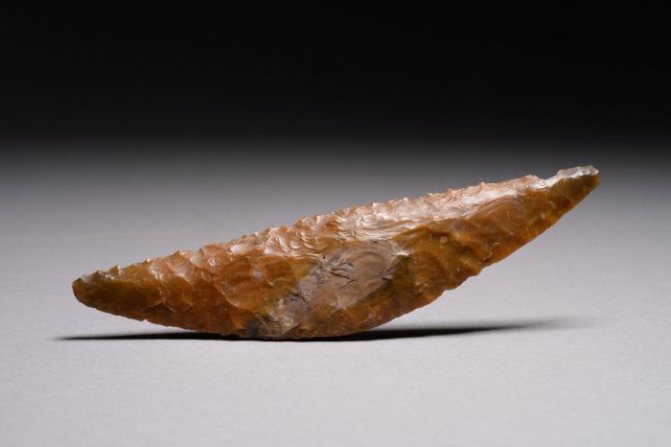
Where is flint mined?
In nature, flint is found everywhere. You can find it without even setting such a goal for yourself. As for production in industrial quantities, in the Russian Federation it is found in the Tver, Moscow, and Belgorod regions. A large number of deposits have been mothballed.
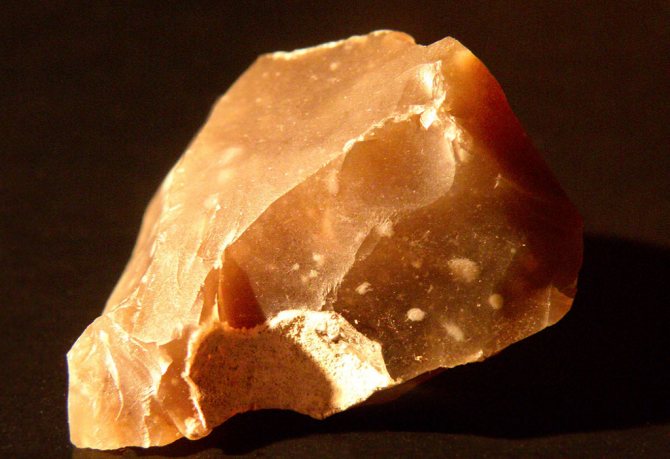
Finding the mineral is not difficult; it is found almost everywhere.
The deposits on the territory of Southern Kazakhstan are interesting. In this region you can find flint in any color, including: white, gray, pink, lilac, yellow, brown.
Precious stones are mined in the Republic of Belarus. The oldest deposit in Europe is considered to be the island of Rügen in Germany on the border with Poland. It was once called Ruyana, and Slavic tribes lived there, and even earlier, the Saxons. Deposits are also being developed in the USA.
Stone flint. Properties of flint. Application of flint
Since ancient times, flint It was with this stone that the entire Stone Age practically began.
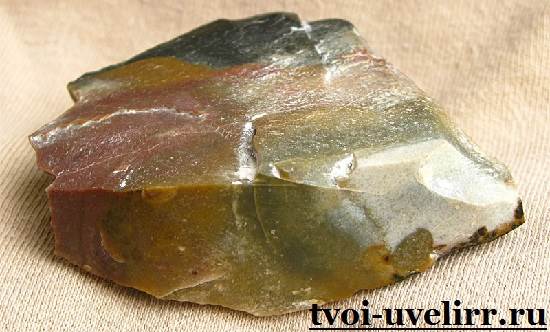
The flint stone has a unique quality - it gives a spark, and it was this quality that ancient people took advantage of to make fire. The word “flint” itself comes from a Latin word that means “to burn.” There is also a version that the name of the stone comes from the Greek word “kremnos”, which means “rock, cliff”.
The stone has a huge number of medicinal properties, so it is often placed at the bottom of a vessel with water so that this liquid, so necessary for human life, is useful and saturated with various microelements.
In addition, flint stone can be split into pieces by applying force. The fragments, as a rule, have very sharp edges that cut well. Therefore, it was no coincidence that ancient man chose this particular stone to create his first tools.
Description of flint
By its nature, the flint stone is chalcedony, which contains admixtures of quartz, opal and ferruginous substances.
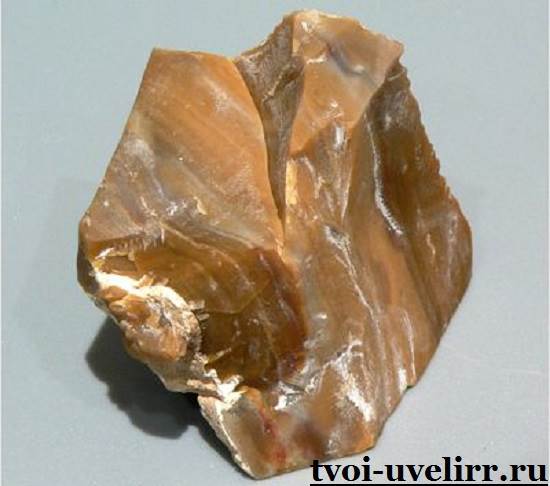
The color of natural stone also depends on impurities; flint is characterized by variations from white, gray to dark tones, such as black, dark brown, and reddish. According to the nature of the color, flint stone can be plain, striped or patterned. Silicon is usually divided into 4 types depending on its composition:
- Quartz-chalcedony
- Quartz-siliceous
- Opal
- Opal-chalcedony.
The luster of this stone is glassy. Hardness is quite high and is about 7 units on the Mohs scale.
Properties of flint
Flint stone has been known for a very long time; it is no coincidence that this natural object has gained such popularity since ancient times.
This stone provides the essentials for human existence, it serves as a source of fire, tools and the first hunting devices were made from it, and it is used to activate water. However, this is not a complete list of all the beneficial properties that this stone has.
Medicinal properties
The most famous medicine is flint water. It is the water, not the stone itself. It is believed that the stone has a very powerful effect on water, it changes the energy structure and also activates water.
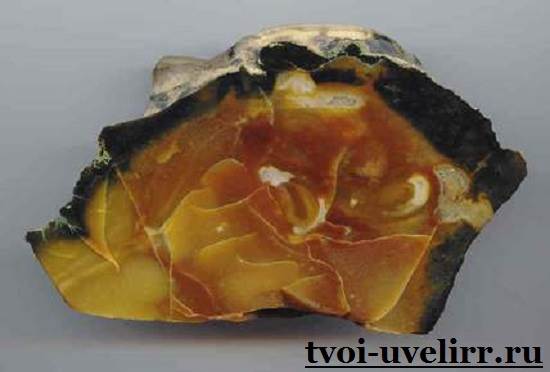
We can conclude that the stone is very useful not in its pure form, but when transferring part of its useful energy to water. However, in its pure form this stone is no less useful. Many claim that flint stone is one of the best antiseptics that exist on our planet.
Flint and water tincture on this stone have a very good effect on the digestive system. Flint cures diseases of such an important organ as the stomach.
Applying the stone to the solar plexus is considered a very useful technique; many believe that it is through this chakra that the flint stone has a beneficial effect on the human body. Regular repetition of this procedure has a positive effect on the body and soul of a person.
Magical properties of flint
The magical properties of the flint stone must be taken into account, because its effect on the body is very powerful. It is best if you wear this stone on your left side. As you know, the most important human organ, the heart, is located on the left side.
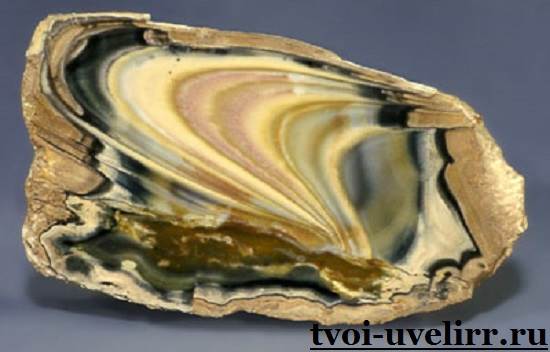
Therefore, the stone, being on the left side, affects this organ and makes the owner a more sincere person, responsive and attentive to others.
If you wear flint in the form of a pendant around your neck, then its main forces will be aimed at imparting firmness to your decisions in any matter, you will become the owner of leadership qualities, you will gain confidence in your abilities and will be endowed with the ability to lead other people.
The magical properties of this magnificent mineral make a person confident, strong, decisive and dexterous. Flint is an active stone, so it awakens the desire for action even in melancholic and very lazy people.
Flint has the property of motivating people to learn new things; a person wants to learn new things, gain knowledge and improve themselves. In addition, since ancient times the stone was considered the patron and most faithful companion of travelers.
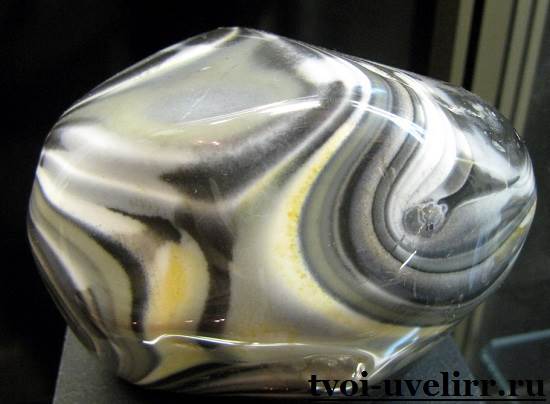
The stone worked wonders during a traveler’s wanderings; it protected against attacks, helped overcome difficult sections of the route, protected from illness and adversity, and even contributed to favorable weather conditions for travel.
If this mineral is located in a home, then it will certainly concentrate all the negative energy in itself, then transform it into a force that has a positive direction.
It is best if the stone is located in every room, then no troubles will befall your home. If this is not possible, then it is better to place the stone in the middle of the space of your home. Thus, the stone will be a kind of center that will radiate special strength and energy, and also act evenly.
Astrologers claim that flint stone can be considered universal; it suits almost all signs of the Zodiac, with the only exception being Pisces.
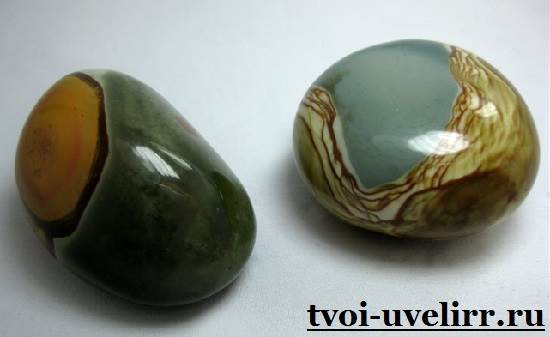
This zodiac sign can become irritable and aggressive when flint is close to them. Many psychics advise those who work a lot physically to acquire such a stone, as it will feed their energy field.
Flint deposits
Flint stone is very widespread and popular. It can be found in almost all countries of our planet. In the Russian Federation, the most famous places where flint is mined are the Moscow region, the Tver region, and the Belgorod region.
The deposits of Southern Kazakhstan are known; it is here that flint of unusual colors is found: gray, brown, pink, yellow, lilac and even deep red.
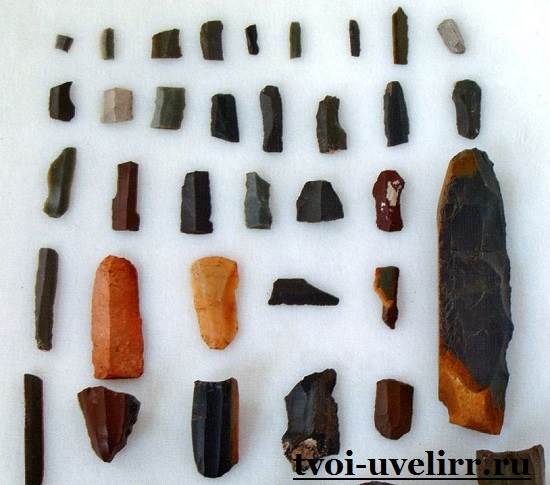
The ornamental material flint is mined in Belarus. In Europe, the island of Rügen, located near Germany, is considered the oldest deposit. The United States also boasts large reserves of this wonderful mineral. Flint is one of the most common, but at the same time the most amazing stones.
Application of flint
Flint is a wonderful material and can be used for many things. The stone is widely used in the manufacture of ceramics. It is used as one of the main elements to obtain unusually beautiful and high-quality material.
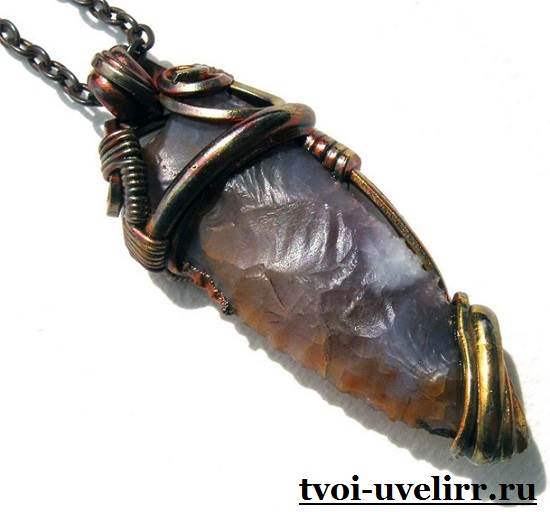
Flint is also used to create abrasive and building materials. Flint has also become popular due to its medicinal and magical properties, so it is widely used in the treatment and prevention of various diseases.
Many people try to acquire a talisman, amulet or amulet made from this stone. This stone is also widely used by people as an interior detail.
Physical and chemical properties
Flint consists of nodules shaped like circles or fingers, with a large number of voids and cracks. Quartz grains are regularly found in the thickness of the stone. All together gives the mineral its unique texture.
On our planet, flint can theoretically be mined everywhere - on plains, mountains, and even at the bottom of seas and oceans. This is one of the most common rocks. The presence of the mineral has been confirmed even on other celestial bodies.
The density of the stone is 2.65 grams per cubic centimeter. The hardness on the Mohs scale is 7 out of 10. Flint itself is opaque, but thin flakes can be slightly translucent. The shine is glassy, unique. The line is white. Conchoidal fracture (that is, from concentric semicircles, reminiscent of mollusk valves). If you split a crystal, you get plates with sharp edges. They are a little dumber than obsidian, but more durable.
The meaning of flint: how is the word interpreted in different dictionaries?
According to Ushakov’s explanatory dictionary of the Russian language, flint is a piece of stone or steel intended for cutting fire from flint. Other dictionaries indicate identical meanings. Encyclopedic Dictionary, 1998 Flint - “an iron or steel plate for producing fire by striking flint. Used from the beginning of the Iron Age to the 20th century.” Great Soviet Encyclopedia.
Flint is a steel or steel product (mostly roll-shaped or rectangular-oval in shape) used for making fire by striking flint. It was common from the advent of iron until the invention of matches in the 19th century. In a number of regions of Europe, it remained in peasant life until the beginning of the 20th century. ABOUT.
Colors and varieties
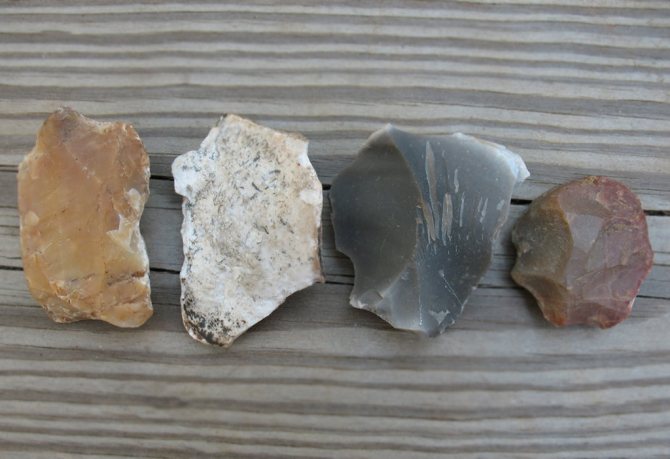
There are stones of different shades, but their properties are the same.
The color of flint can vary greatly depending on the rock in which it was formed. They are influenced by the color and impurities that enter the rock during its formation. Main shades of stone:
- pink;
- lilac;
- red;
- black;
- light brown;
- dark brown;
- blue;
- grey.
There are almost never one-color copies. In the stone you can see inclusions and grains of various shades. The most common variety is black flint. From the point of view of chemical composition, the rock is divided into four possible varieties: siliceous and chalcedony quartz, chalcedony opal, opal grade.
Despite the differences in the structure of the crystal lattice, all the minerals on this list have similar properties.
Flint deposit
This type of stone is not classified as rare and is found in almost all corners of the planet. The oldest deposit is considered to be the island of Rügen near Germany. Flint is also mined in Russia - in the Moscow region, Tver and Belgorod regions.
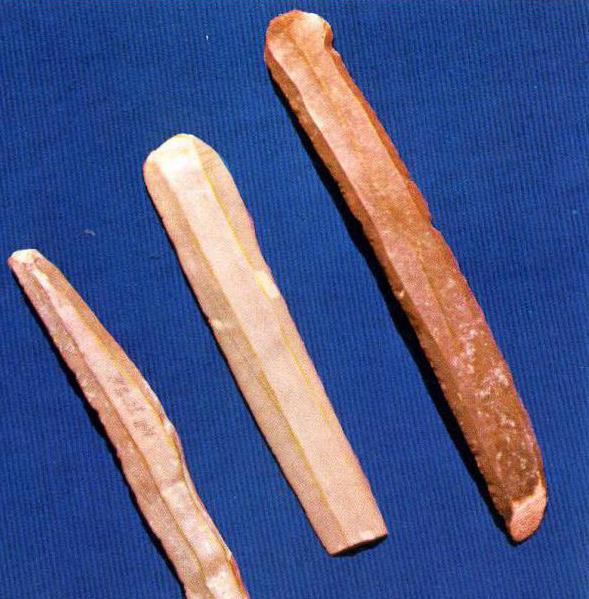
There are known deposits where flint of very unusual colors is found - this is mainly in the south of Kazakhstan. There you can find stones of pink, lilac and bright red colors.
Where is flint used?
Due to the properties of flint, the mineral remains popular as a facing and ornamental material. It is used together with limestone and granite in construction and decoration. Some of the stone's patterned relatives, such as jasper, are used in jewelry.
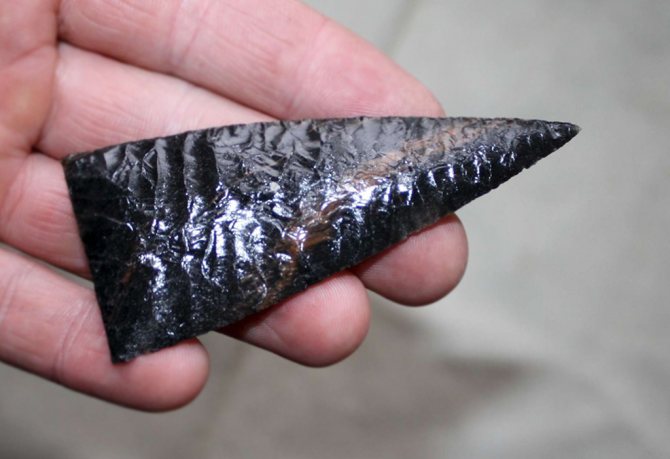
The tip of a spear, these were used in the Stone Age.
Flint figurines and vases can decorate a home and give it a special touch. Ornamental varieties are worn as part of inexpensive but spectacular pendants, bracelets, beads and pendants. You can also use the stone in its natural form, that is, simply store the beautiful mineral on a shelf along with other similar specimens. In the magic of gems this is quite acceptable.
In the halls of special events or in metro stations, facing slabs made of rare types of stone are used. An example would be the floors of the Annunciation Cathedral and the Moscow Kremlin. The mineral is also used for laying roads and highways. In general, we can safely say about flint that it is everywhere, and we simply do not notice it.
Healing properties of the stone
It is difficult to say who was the first to discover that water infused with flint has the properties of a medicine. It is believed that black, gray or dark red types are best suited for such charging. The stone is able to change the molecular structure, remove harmful toxins and fill the water with positive energy. You can wash your face with the resulting liquid, or you can just drink it. Many other beneficial properties are also attributed to it:
- Flint has the ability to relieve pain in different parts of the body. Water charged on the stone can ease physical discomfort.
- Lithotherapists also believe that it can strengthen the immune system, that is, it helps prevent infectious diseases during the season of ARVI and colds.
- The mineral has rejuvenating properties. Water infused with it accelerates the healing of wounds and injuries and improves metabolism. In alternative medicine, it is generally accepted that in this way the remedy slows down aging.
- If you wash the wound with flint water, it will cleanse faster and the bleeding will stop.
- It helps with diseases of the kidneys, liver and gastrointestinal tract.
- Thyroid pathologies will also recede if you regularly take the charged liquid.
- The manifestations of food and alcohol poisoning are alleviated.
- Mouth rinsing is a good prevention of periodontal disease.
- Water lowers blood sugar in people who suffer from diabetes. Lithotherapists advise such patients to drink it regularly.
- If you drink liquid if you are anemic, it will quickly compensate for your iron level.
- Flint can prevent pressure drops. When the patient feels that a crisis is approaching, you can drink some water infused with it.
- The stone-charged liquid alleviates the manifestations of glomerulonephritis.
- Lithotherapists advise rinsing your hair with flint water - this is an excellent remedy for seborrhea and dandruff.
- Regular washing with stone medicine helps get rid of acne, blemishes and blackheads on the face.
Therapeutic uses of flint
The healing properties of the mineral have been noted for a very long time. Silicon served as the main component in the life-giving drink: a pebble was immersed in ordinary water and waited for a certain period. This liquid was used as an antiseptic and a reliable antibacterial agent.
In Mongolia, local shamans used this drink to treat stomach and intestinal diseases. Chinese healers traditionally use the stone. Their method of treatment is application to the solar plexus area.
Modern lithotherapy recommends carrying flint with you to prevent chronic ailments of the central nervous system, lungs, heart, and kidneys. For fractures, you need to drink silicon water and apply stone plates to the problem area. This miraculous mineral also helps eliminate inflammation and suppuration. Silicon therapy is also used in psychotherapy. Contemplation of jewelry or individual stones optimizes the state of the nervous system.
Magical properties of flint
In addition to treatment, there is another area of application - amulets and amulets. Flint is a quite powerful talisman; this was known to the shamans of primitive tribes. It is recommended to wear it in the left pocket, near the heart, so that its energy saturates the wearer’s aura. It helps maintain inner core and maintain mental balance. If you wear an amulet around your neck, it will strengthen the leadership qualities of the owner.
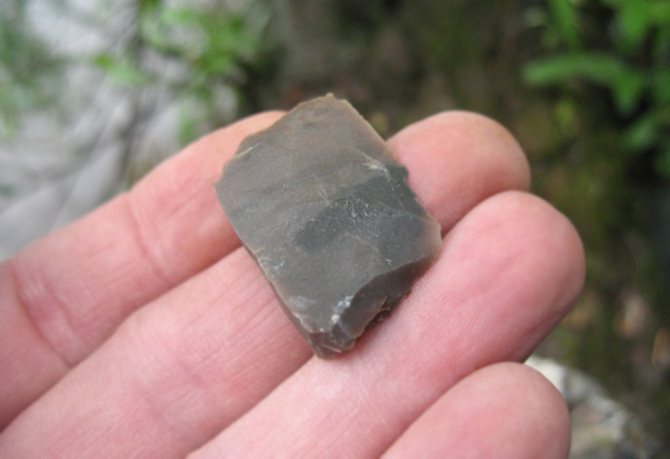
The talisman is recommended to be worn near the heart.
Also in the magic of stones, there is a common point of view that flint makes the wearer more resilient, dexterous and strong. His energy is very active and active, it motivates even the most pronounced lazy people to action. The mineral helps to acquire new knowledge.
It is also capable of protecting a traveler on a long journey. Flint protects a person far from home, shows the right path and sends good travel companions. A truck driver or just a tourist can be sure that they will return safe and sound from a trip if they wear the amulet around their neck.
To ensure that your home is not exposed to any troubles, it is recommended to keep a flint product in each room. For people who cannot afford this, it is enough to hang a talisman over the door so that the stone will neutralize the negativity of everyone who enters the house.
The healing properties of the mineral
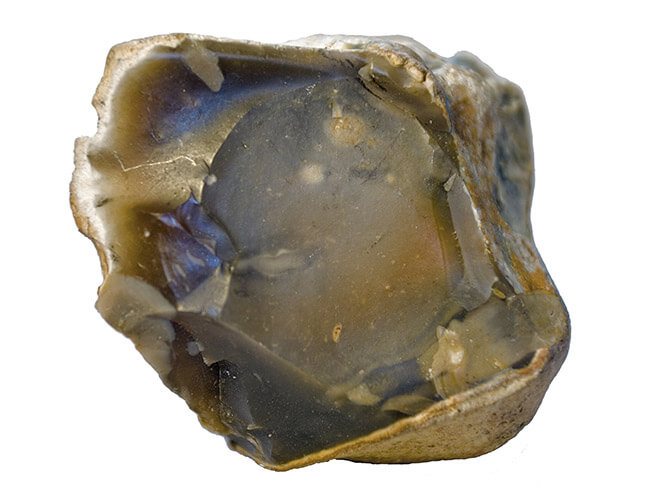
Already in ancient times, people noticed that silicon has some healing effects on the human body. Using it, they began to prepare “flint water,” the so-called life-giving drink.
Ordinary water, when a stone is placed in it and kept for a certain period of time, changes its energy, is charged with positive energy and is able to impart it to a person.
When used in the treatment of certain pathologies, flint water is considered as an antibacterial and antiseptic agent. This magical liquid can prevent the occurrence of infectious pathologies. Mongolian shamans and healers found wide use of flint water in the treatment of diseases of the gastrointestinal tract.
The technique was simple: the patient was asked to drink a small amount of liquid every day before eating food, and apply the mineral itself to the solar plexus. Chinese healers also valued the stone and even today, it is used in the treatment of many diseases by applying the stone to the solar plexus area.
Recommended to carry with you as a talisman against many chronic diseases of the nervous system, heart, and other vital internal organs.
Who is suitable for flint according to their zodiac sign?
The properties of the flint stone make it compatible with almost all zodiac signs. Thus, Gemini and Aries, thanks to the action of the talisman, will be able to become more diligent, purposeful and active. It will be easier for them to achieve their goals, no matter how difficult they may seem.
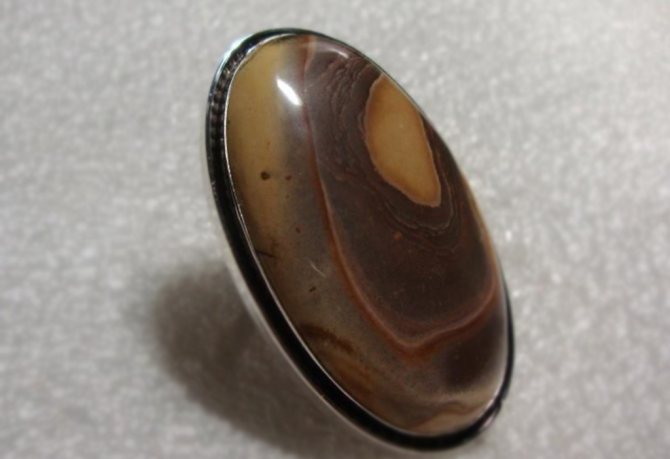
Cancers , Virgos , Libra will note that it is easier for them to achieve peace of mind. Flint will help you not to give in to emotional impulses and do stupid things like no other stone. Aquarius will feel protected from any negative influences.
However, astrologers do not advise those born under the sign of Pisces to wear a stone. Their aura can conflict with the energy of flint. However, if you really like the amulet, or a loved one gives it to you, then there will be no problems with it.
Are you choosing a talisman stone? You may also be interested in black obsidian, rhodonite, beryl. Enjoy reading!
What can act as tinder and wick
In conditions of autonomous existence, when the issue of survival comes first, the primary task is to make fire. However, sometimes the resulting spark goes out before it has time to grow into the flame of a fire. Typically, dry paper is used to maintain the fire. If it is not at hand, the functions of the wick and tinder are performed by:
- cotton wool fluffed or smeared with petroleum jelly, cotton insulation;
- handkerchief;
- old, torn T-shirts, sheets and other rags;
- napkins, wax or toilet paper;
- cotton pads, tampons;
- dried mushroom Tinder fungus;
- wood shavings, small chips;
- old reeds, reeds, cattails, bamboo;
- Birch bark;
- dry grass;
- old dry moss;
- pine needles, fir cones;
- burnt fabric.
If you find yourself without a match or a lighter in the forest, you just need to look around and a suitable means of ignition will be found.
Some people store tinder for future use and then take it with them. Here are their recommendations:
- Store the product in sealed freezer bags. Durable products do not allow moisture to pass through, maintaining the high flammability of tinder.
- When going on a hike, transfer the contents of the bag into a special sealed container. If you leave the tinder in the bag, it will become damp and lose its value.
- Before use, fluff up and separate the material into fibers. This will speed up the formation of a spark and flame.
- Fan the tinder until it chars and full flames appear. Only then add kindling and wood.
This “non-match” method came to us from antiquity. Initially, primitive people made fire by rubbing dry pieces of wood against each other for a long time.
Later, they began to carve out a hole in the board, which was lightly sprinkled with dry leaves or grass. Then a rod-stick was inserted there and intensively rotated between two thumbs. This continued until the tinder burst into flames. To speed up the process, use the following recommendations:
- use dry wood of cypress, cedar, willow, aspen, pine, walnut;
- for more convenient rotation, use a rod 60 cm long;
- during rotation, lightly press the stick against the base board;
- as soon as the first spark appears, carefully blow on it to speed up the process;
- as soon as the contents of the recess flare up, place dry bark, moss, etc. under the board.
Like making fire by friction, this method requires a dry piece of wood and a stick - a rod. But the main device is the bow. By maintaining the required pressure and high rotation speed of the rod, the bow speeds up the combustion process.
The upper end of the wooden rod is wrapped with a bowstring, and the lower end is inserted into the recess and the bow is intensively moved away from you (the wooden base of the bow is perpendicular to the rod). Don't forget about tinder. As soon as it sparkles, add dry wood chips and light the fire.
It’s unlikely that anyone takes a bow on a hike, so you’ll have to build it on the spot:
- Find a flexible but strong vine (the length of the bow should correspond to the length of an adult's arm).
- Use strong rope or shoelaces as a bowstring (the main thing is that the bowstring can withstand the process of making fire).
- Pull the string over the ends of the vine.
Despite the complexity and energy consumption, in our latitudes, this method of making fire is the most preferable. There is a variation of the firebow called the "pump drill". But this method of making fire is so complicated that it is practically not used.
To start a fire without matches, glasses, binoculars or a magnifying glass will be useful. It is enough to catch the sun's rays and direct them to the tinder, laid in the form of a pile with a hole in the center. Keep the lenses still. After some time, smoke will begin. Gently fan the fire.
The following chemicals are flammable when rubbed or mixed:
- Sugar with potassium permanganate in a ratio of 9:1. Sprinkle manganese on a piece of cotton wool, then sugar, rub the mixture with a stick. Within 2 minutes, the chemical tinder will ignite.
- Sugar and bertholet's salt 3:1.
- Manganese and glycerin. Sprinkle a pinch of manganese on a dry cloth, top with 3 drops of glycerin. As soon as smoke starts to appear, add a couple more drops. A bright flash will be the signal to start a fire using tinder.
- Potassium permanganate with any coolant. Sprinkle a teaspoon of potassium permanganate onto a piece of cloth, and add 3 drops of antifreeze on top. Roll up and place on the ground. Sprinkle tinder on top. The oxidation process leads to heating of the mixture and ignition of the package. Attention! Excessive dosage of antifreeze or a package that is not tightly folded will reduce the heating rate.
To prevent the search for chemicals from becoming a problem, it is better to take care of the contents of your first aid kit in advance. Bertholet's salt is part of Furacilin. And manganese crystals and glycerin are sold in any pharmacy.
No need to experiment with the ratio of ingredients. Increasing dosages will not speed up the combustion process, but will increase the likelihood of chemical burns.
Flint, which is the predecessor of ordinary matches, will help you start a fire in natural conditions.
Having a silicon stone on hand, you can strike a spark literally from the second glancing blow with a hammer.
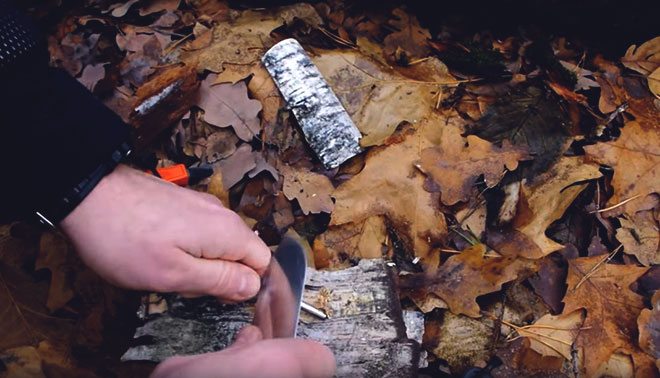
Any metal object can serve as a chair.
The role of a knife can be performed by any metal object: the back of a knife blade, an ax blade, a file. The trajectory of the falling sparks and the location of the harvested tinder must coincide.
Condom
A kind of lens is made from a condom. To do this, the contraceptive is filled with water, given its most rounded shape, tied, and the “rubber glass” catches sunlight. Focusing the beam on a pile of prepared tinder, wait until smoke appears (distance no more than 5 cm from the tinder).
Then they carefully fan the flame, add brushwood and light the fire. Instead of a condom, you can use a balloon.
Flashlight
It’s not difficult to start a fire without matches if you have a flashlight on hand that you don’t mind breaking. More precisely, break the electrical part of the light bulb. The exposed electric arc is brought to the prepared tinder and set on fire.
Skating
This method of lighting a fire without matches came to us from not so remote places. And form a piece of cotton wool into a kind of roller. Roll it intensively on a dry wooden surface until the cotton wool is saturated with oxygen and increases in volume. Oxygen will start a combustion reaction, and the material will begin to smolder.
Sweet lovers do not realize that the usual tandem in the form of a chocolate bar and a can of drink can save lives far from civilization. A clear sunny day and the following steps will help you light a fire with the help of “sweets”:
- remove the chocolate from the wrapper and rub it on the outer bottom of the tin can;
- when the polished bottom shines like a concave mirror, turn it towards the sun and set fire to the tinder spread out at a distance of 3 cm with a caught ray.
Don't be upset if you don't have chocolate on hand. Toothpaste is suitable as a polishing composition.
Wool and batteries
Making a fire without matches is not a problem if you have batteries and a cloth made of natural wool on hand (a strip 15 cm long and 1 cm wide is enough). Rub a stretched piece of fabric with a battery with a power of about 9 V.
Be patient. As soon as the smoldering process begins, blow on the wool and add dry sawdust or leaves. Hurry up, because wool doesn't burn for long.
Empty the bullets/shot and some of the gunpowder from the cartridge, fill the cartridge case with crushed cotton wool or dried flowers and fire a blank shot at the fire site. All that remains is to fan the fire and throw the prepared brushwood into it.
If you have a silicon lighter that has run out of gas, the situation of losing matches is no longer critical. The first method of starting a fire requires soft and dry toilet paper. Dense and rough is not suitable. So let's get started:
- remove the protective cover;
- fold toilet paper into 5-6 layers, tear and stack the pieces so that the side of the tear faces one direction;
- in the place from which sparks are emitted when the wheel rotates, press the lighter against the stack (the sides of the gap are directed towards the sparks);
- “roll” your palm along the wheel, striking sparks on a stack of paper (repeat the manipulation until smoldering begins);
- fan until a flame appears.
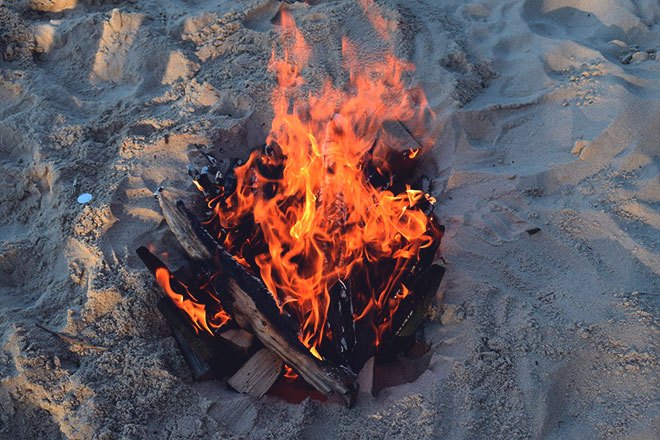
If you don’t have soft toilet paper at hand, use the second method:
- remove the cover;
- loosen, knead and bend the center of a notebook or any other sheet so that a funnel is formed in the center (this is an important point, without which the task of starting a fire will become more difficult);
- place the lighter horizontally over the paper;
- be careful not to spark, and slowly turn the wheel until a sufficient amount of powder appears on the paper;
- collect a mound of powder in the loosened center of the paper;
- Turn the lighter wheel over the powder until a flash appears and the paper ignites.
In field conditions, the following are used as a concave mirror:
- a removed reflector from a car headlight/flashlight;
- concave bottom of the gas cylinder;
- a tablespoon deformed to the shape of a concave mirror;
- a tin can, the bottom of which is polished with a dry, rough cloth.
The “tin can and chocolate bar” method, which was described above, also belongs to this group. Accordingly, fire making is carried out according to the same principle.
During the sharp impact, the metal heats up, and the high temperature spreads to the tinder. To start a fire you will need nails 10 cm long, a hammer, and an anvil.
These items are unlikely to be found in a travel backpack. This means that if you find yourself far from the city, you will have to improvise. For example: a nail is a piece of rod or other metal object; the anvil and hammer are stones (however, in this case, it is more difficult to get fire). Let's look at the procedure:
- Roll the newspaper into a tube and press it with your foot to prevent it from unwinding.
- Hit the nail lying on the anvil several times with a hammer.
- Place the heated nail against the newspaper and leave it until it begins to smolder.
- Inflate the newspaper until a flame appears.
